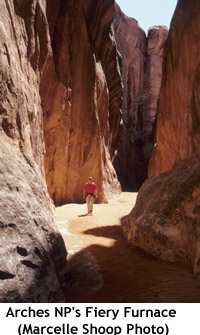There's nothing quite like getting out of the office to test the product. I was able to do that this past weekend, blasting about four-and-a-half hours south from Park City and the snowy Wasatch Range for sunny, and almost hot, Moab, the gateway to Arches and Canyonlands national parks.
 These twin testaments to erosion are a quick cure for cabin fever. With their sandstone monoliths, sweeps of sand, cacti, yucca, pinyon pine and juniper, these two parks offer much for those in search of introspection or communion with nature.
These twin testaments to erosion are a quick cure for cabin fever. With their sandstone monoliths, sweeps of sand, cacti, yucca, pinyon pine and juniper, these two parks offer much for those in search of introspection or communion with nature.
Along with my wife, youngest son and some neighbors, we spent Sunday wending our way through a section of backcountry in Arches, squeezing through slots and clambering over massive boulders and sheets of rock so we could rappel down a level, hike some more down a dusty wash, and rappel some more.
Canyoneering is a mostly benign sport. With very few exceptions, you leave no trace. With only one out-of-the-way exception that I saw, temporary anchors created by webbing and ropes leave no physical sign of your trek, while the winds and occasional cloudbursts sweep away your footsteps.
Thanks to the expertise of Desert Highlights, a Moab-based guide service licensed to operate in Arches and much of the surrounding landscape, we were able to explore parts of Arches that most folks don't see. If only for a day, our small group was able to leave roads and combustion engines, newspapers, radios and televisions behind and test our muscles against age-old rock.
We ate lunch beneath the graceful curve of a remote, almost hidden arch named after Ed Abbey, a distinction he no doubt would have railed against, but one of immense meaning to those who share his belief that wilderness should forever be left wild, that this stark landscape holds more beauty than a fine art museum. Against a backdrop of gentle breezes, of cawing ravens and skittering lizards, we enjoyed a day away from the crush of humanity and tested our muscles and our innate desire for self-preservation by dangling 100 feet off a cliff in a pristine and dramatic setting that only nature could build.
 Getting back to these basics is one of the privileges allowed by national parks. It's a privilege that makes it so easy to understand and appreciate the national parks movement, one that at the same time makes it so hard to understand why we can't get more support to protect the national park system.
Getting back to these basics is one of the privileges allowed by national parks. It's a privilege that makes it so easy to understand and appreciate the national parks movement, one that at the same time makes it so hard to understand why we can't get more support to protect the national park system.
Arches is one of the fortunate national parks. It has a practically brand-new visitors center that succinctly explains the desert ecosystem and geologic machinations that created this landscape, and few other buildings that demand attention. Its relatively short road system isn't under siege from months of freeze and thaw or heavy snows, and the one campground is nicely policed and never overrun.
True, it'd be nice if the park had the resources necessary to hire enough interpretive rangers to conduct all of its tours into the Fiery Furnace and other areas of the park, but the volunteers do a pretty good job in their place.
Springtime in the Rockies often is hard to take root, and being able to flee it for places like Arches, Canyonlands or Zion National Park is a perfect tonic to help one recover from nearly six months of winter. To see these places up close and reveal in their surroundings is easy to take for granted, but it's something we never should.



Add comment